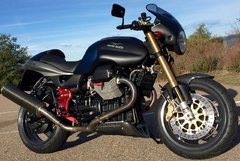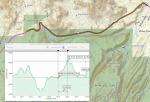-
Posts
4,123 -
Joined
-
Last visited
-
Days Won
253
Content Type
Profiles
Forums
Events
Gallery
Community Map
Everything posted by Scud
-

ANSWERED Altitude Sickness - running weak in the mountains
Scud replied to Scud's topic in Technical Topics
Well, it's not really a big problem - just a puzzle about optimum tuning for big elevation changes. I missed doing the Sherman Pass (9,500 feet) last season and want to try it again this summer. The bike just didn't have the brutish punch on the high climbs, it felt like it would only go 3/4 throttle. However, it did manage to run sections of this long incline in 6th gear and 5-6k rpm. It idled a little rough when I stopped at the peak to soak in the view. -

ANSWERED Altitude Sickness - running weak in the mountains
Scud replied to Scud's topic in Technical Topics
1: Good point, I hadn't considered that. 2: There are no sensors in the exhaust. I replaced the 2003 crossover headers with non-crossover headers from a 2002 bike. The original exhaust also did not have any sensors. So, I guess that means I am running an open loop system. FWIW - the bike also has FBF crossover, the factory Titanium exhaust and unmodified Titanium ECU installed. I have to do some scheming to figure out how to get over 7,000 feet again soon... -
On my recent trip the Sierra Nevadas the LeMans felt a bit weak, especially at higher elevations. During the weekend, I never got below 5,000 feet, nor above 9,000 (blocked by snow). I've been running the valves kind of loose: .008" I and .010" E. My house is at 100 feet above sea level - so that's where I tune it. So... I'm wondering if a loose valve setting could cause a bit of an intake restriction in thinner air. I can't do any quick tests... so this is a "theoretical" topic. Edit - I am assuming that the looser the valve clearance, the shorter the duration of time the valve is open. So if the air is thinner, it might not get enough oxygen to burn the fuel. I also noticed some small pops on deceleration at the highest elevations - mini backfires - which made me think that unburned fuel was igniting in the exhaust. Am I thinking about this the right way?
-

Will California Special valve covers fit a V11 Cafe Sport?
Scud replied to polebridge's topic in 24/7 V11
Was that $150 for one cover? Here's a cool aftermarket pair on ebay: http://www.ebay.com/itm/Moto-Guzzi-Custom-VALVE-COVERS-Big-Blocks-Square-Fin-Heads-1100-/131655506299?hash=item1ea747997b:g:4S4AAOSwkZhWTMhH&vxp=mtr I have a pair of original covers that are painted grey, but have some scratches from the bike being down. I think a good shop could polish the scratches out. -
I'm not sure. I just looked at the parts diagram again and still can't tell. My best guess is that the axle only rides on the inner bearing races, not the seals. So I think I may have asked an irrelevant question above. But since you have ordered seals, you will be able to test if the inner diameter of the seal is the same size as the axle.
-
Thanks. We've been really happy with the small Toy-Hauler trailer - bought it used several years ago. It's got a small bathroom and kitchen (gas/electric fridge, stove and oven, microwave), on-board generator, and about a 15 gallon fuel tank with a pump for refilling the "toys." I can always leave camp with a full tank. Sleeps 5 easily when all the beds are folded down. I was towing it with my 2005 Tundra at first, but that's become my daughter's truck since I got the F250. The 7.3L turbo-diesel is much happier pulling the big grades with the trailer - the 4.7L gas Tundra was near the limit. Funny thing about the old (1997) Ford. The kids and all their friends love it - even more than the super-expensive new trucks that some of their families have. They like the front bench seat (they fight to get to sit in the front middle spot), the fact that the back seat is covered with an old Mexican blanket, and the beat-to-hell inside of the truck bed. When the trailer is at home, it serves as the "parts department" or "project staging area."
-
Can you describe the problem in more detail? You might check your relays (or replace them with higher quality relays) and check/clean all the connections, especially the ground wire at the back of the transmission.
-
OMG (Oregon Moto Guzzi)
-
How's the condition of the axle? If there is significant wear (over100,000 miles) or longitudinal scratches, could that let some oil escape - even if the seals are in good condition?
-
Hmmm. Setting aside the time-bomb self-grenading clutch, that ultra low milage is worrisome.....I prefer my used machines to be already somewhat fettled....there's a lot to do on this machine in addition to the clutch upgrade. Add 1500-2000 not including the buyer's labor to bring it up to snuff... That being said, I do really love the Tenni Lemans....but I must resist, I already have 2 temperamental Italians in the garage.... My Scura had less than 200 miles on it and has been trouble free for over 10,000 miles. I admit that I have done a lot of work to it, but most of it was cosmetic and totally optional. The only "real" problems I had were two oil leaks, one at the timing cover and one in the transmission. I didn't even have to service the suspension till 10,000 miles. I did replace the flywheel/clutch - but I wouldn't hesitate to use the original flywheel/clutch for an oil change or two. And then we have the bubbling engine paint... and the same paint on the tranny. Mine had been stored in someone's home as art. Sounds like this one was treated similarly. I think it would probably be a good rider.
-
The trailer is a 19 foot toy hauler - one of the smaller toy haulers available. The bikes ride inside like this: The whole back drops down as a ramp, and a not-too-shabby picture-window. My daughter strung up all 5 fishing poles. This is how I tied the LeMans in. Wheel chock up front with turnbuckles and snap-rings to the floor hooks. Rear straps prevent forward movement, and side straps with very light compression on the suspension. A benefit of running without side panels is that the straps can go around the subframe instead of the exhaust hangers, which have a pretty weak weld. The white on the back tire is because a chalky section of road in the campsite.
-

Will California Special valve covers fit a V11 Cafe Sport?
Scud replied to polebridge's topic in 24/7 V11
You could compare part numbers for the valve cover gaskets. If the V11 uses the same gaskets as another bike, there's a pretty good chance that the covers will be compatible. -
Funny story behind that picture... Mono Cone is a favorite stop for our family when we are in the area. After hauling the trailer up all day Friday (with family) I took a quick rip up to Lee Vining (via route 120). I took the selfie and group-texted it to family (wife and 3 daughters). My oldest texted back "that's savage" almost immediately. Then they all had Thrifty ice cream from the trailer's freezer, which turned into a bit of a running joke over the weekend. At least it was funny to me... maybe it's one of those "you had to be there" things.
-
That was 2 years ago, I just updated this topic with my recent re-visit rather than create a new topic. Anyway - the article about the rockfall is still available if you follow the link above. It says nobody noticed the rockfall until some rock climbers noticed that their route had changed.
-
I almost got motivated to clean it this evening - but it's gonna be a couple hours once I get started. Bug guts and wings are all jammed up in small places like cooling fins. I was grateful for the LeMans fairing on this ride, but my helmet, boots, and leathers were sticky. Multiple visor cleanings - one following a series of seriously vision-impairing impacts.
-
Return trip... this time earlier in the season and camped at lower elevation in the Owens River Valley. This is approaching Benton Hot Springs, which is near the Nevada border. The Eastern section of Highway 120 peaks at over 8,000 feet with a stunning view of the Sierra Nevada Range... ...on the way to Mono Lake... and the city of Lee Vining, home to Mono Cone and probably the best swirly ice cream in the whole world. Highway 120 continues up and over the Sierra's Tioga Pass. But the pass was closed because some of the road is still under 70 feet (yeah that's 21 meters) of snow. It's up there somewhere... the streams were flowing and the trout were elusive. And a few more pics...
-
Moto Guzzi Moth Massacre
-
The riding is great if don't mind all the curves, elevation changes, scenery, and that fact that there's nobody else on the road. This is near Benton Hot Springs. Sent from my iPhone using Tapatalk
-
Mono Lake from Route 120 Sent from my iPhone using Tapatalk
-
So a Sucra will make noise in neutral? What is making the noise? That remains a mystery to me, but the noise goes away when lever is pulled in. My best guess is that the flat (blade-type) clutch springs are free to bounce or vibrate a bit when they are not under pressure. Then, when the lever is pulled, it forces the push-cup into the pressure plate and the springs can't bounce - and then no noise. By contrast, the twin plate makes noise with the lever in because the stack of plates in the flywheel becomes loose. Then the teeth of the pressure plate and intermediate plate rattle inside the flywheel's teeth. The wear patterns on flywheels show this.
-
PJ - it seems that some of the original Scura flywheels have lasted for a while, but many have found small cracks when replaced pre-emptively. I ran mine for about 10,000 miles and it showed no signs of fatigue when I removed it. I felt comfortable with that amount of use, because it seemed most of the failures were on the other side of 20,000 miles. You have to make your own decision, but for me, the uncertainty and the potential cost of failure were the main factors that led me to replace it early. Grab a beer (or several) and read all the threads that come up when you search things like "Scura Clutch" or "Single Plate Clutch Failure." A little camera, and a flywheel inspection at each oil change, might remove the uncertainty for you. However, I think the cracks would start around the bolt holes where the flywheel mates to the crankshaft - and that these would be difficult to detect. By the way - my comment about the noise being the clock on the time-bomb was in jest, but there is a grain of truth in the joke. The noise as you describe it totally normal for the Scura. I think the "flywheel as time bomb" is real - but it's a silent killer that gives no notice in advance of failure.
-
That is the sound of the clock that operates the time-bomb on the original Scura flywheel. voycie - not to worry, you have a reliable twin-plate clutch/flywheel.
-
Very nice Rox. I like that carbon flyscreen too. Do we need an Italian flag in the garage?
-
Loaded up the camping gear.



